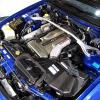Spring Rate Ratings
Announcements
-
Similar Content
-
Latest Posts
-
By Dose Pipe Sutututu · Posted
Probably best way would be using a proper dB / SPL meter lol Buy one and ship it from state to state to have a consistent test device lololol -
Not electric car good of course, it's still just a crappy old ICE
-
Yeah, but the good news is that can all be tuned out...the V37 has excellent throttle response now, and with the tiny factory turbos is pretty quick without lag
-
I did change bodyshops. The most recent place was very fast. I think the trick is to have smaller, simpler jobs. A front end repaint and some (extensive) sideskirt and fender stuff is a 'small cash' job for them. It was expensive but 'worth' it purely cause: 1) They did everything great 2) They did everything fast Get what you pay for maybe? Pictured: Very stock looking car from my very old phone. I did realise that oncoming traffic would probably be like "Oh look at this guy, commuting around in a GTR!" (until they see the side profile). This is the sad state of my fender liners and front fitment with my current stock GTR sized wheels (18x9 +30) This is how the rear sits with a 25mm spacer. I say 25mm because it's actually a 20mm spacer sitting on the studs which are ~30-31mm, and the wheels have a ~5mm cutout. So... this is very not safe to drive. This is the other side.. .with a 22mm spacer. Yes, the studs are ~27mm. Yes they're different both sides. I spent a fair amount of time measuring. This was the old pod setup behind the box in the past. Old vs New Pod she tells you not to worry about: Turns out I measured this pod filter pretty damn accurately which I was chuffed about. I went for a ~3hr drive for 'testing' reasons up into Healseville hills. Believe it or not, the induction noise is the same between small and large pod. I guess it has more to do whether a pod is *present* or not, and the diameter of the pipe. It does sound very decent in cabin though (and extremely 'smooth') - Though behind the car the exhaust noise is nonexistent now. So uh, it's all for the driver. I'm confident it has to be quieter than @Dose Pipe Sutututu's car. I should test it. Is there a way to do it with an app or something we can both agree on? (we are both very old men now competing for quietest car) I've texted Trent at Chequered to book in to see some before/after. I can now twist the pod entirely out of the engine bay on the dyno to really rule in/out any intake restrictions. And/or remove the pipe entirely which I will probably do for testing reasons. The logs show *maybe* a difference in ambient KPA vs Intake KPA at wot. But I'm talking the difference to -3/4 before to maybe -2/3 now. The tune is not wildly out or even changed at all. The only takeaway I have is the car is on 17% ethanol as it's still got the fuel from the dyno in it. It's plausible that that tune would have resulted in the car erring on the side of being too rich (it was) and right now it seems to be bang on perfect or within -0.5% either side of target. I was tempted to take it to a Drag day to see what MPH it would trap (and tune the car) but then I wouldn't have a number and a pretty line. I may do that after I re-hit the dyno, purely to go to LS1tech and shout about how their dynos are all very inaccurate while my low HP car traps the same MPH as cars with the same setup in the US, who make 375RWKW (supposedly). It was safe to say Mr Mamo was not really happy with me posting the results yet. So I owe it to at least try the intake thing for my own sake and not besmirch people who want to buy a similar USA heads and cam setup and get disgusted that they make lower HP than simple bolt-ons which can be up to the "330rwkw+" kw region over there - Which here equates to about 270kw. (and runs the same 115-118mph)





Recommended Posts
Create an account or sign in to comment
You need to be a member in order to leave a comment
Create an account
Sign up for a new account in our community. It's easy!
Register a new accountSign in
Already have an account? Sign in here.
Sign In Now